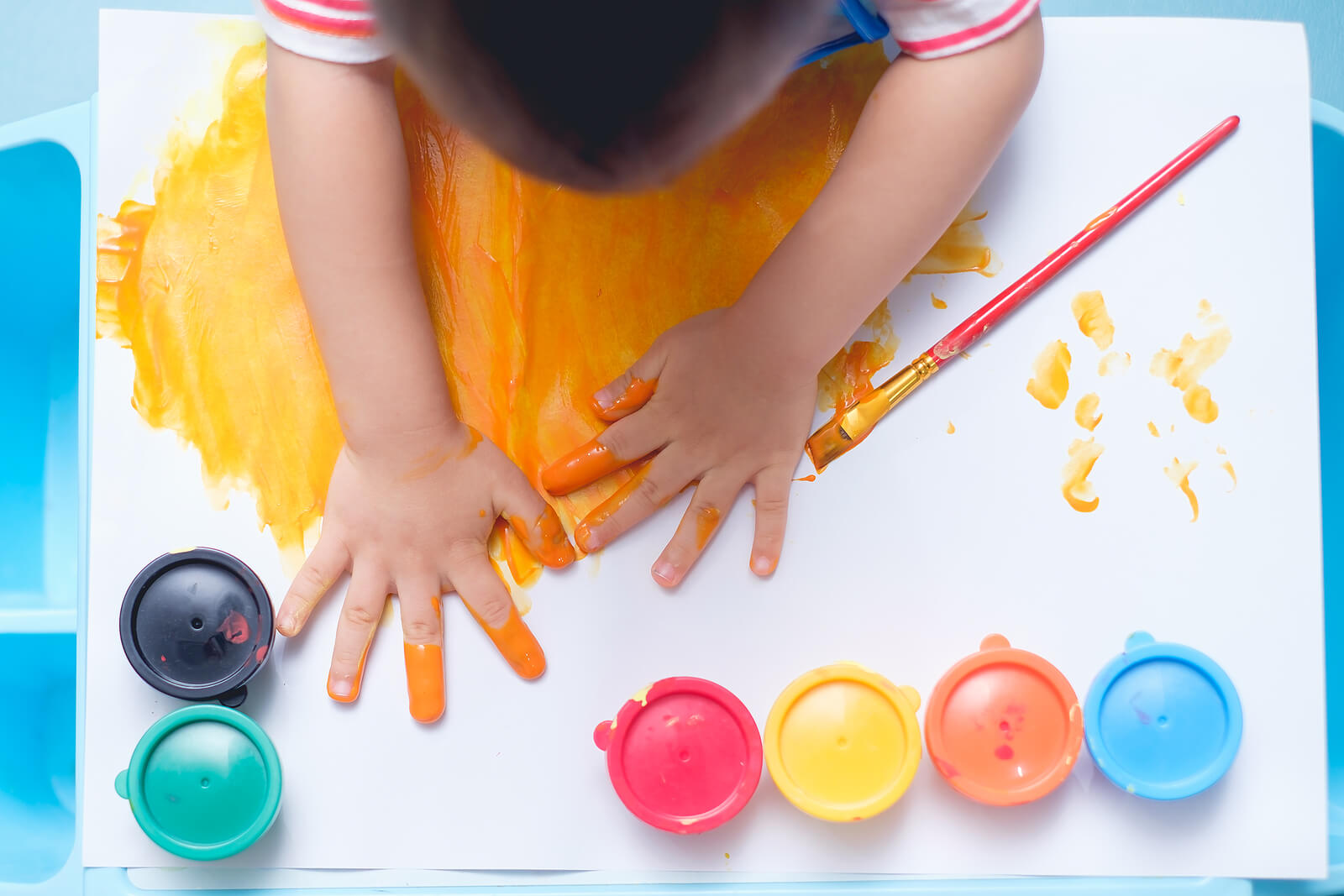11 Activities that Stimulate Children's Skills

Little ones have incredible skills and their brains are eager to record everything they discover. For this reason, it is important that during early childhood you propose activities that stimulate your children’s skills.
To do so, you don’t need to be a teacher, psychologist or therapist. Just exercise your role as a parent and encourage your child to learn through play and fun.
Grandmothers say that “children are like sponges” and they certainly are. They absorb everything they see or hear, imitate others, and learn with great enthusiasm what they are taught in a playful way. Read on and find out more!
Activities to stimulate your children’s skills
Here are some of the activities that stimulate children’s skills and are suitable for all ages and places. Test your children’s ingenuity, creativity, and intelligence, and have a great time together.
1. Finger painting
One of the most fun and easy activities to do is finger painting. All you have to do is lay out some leaves and water-based paint. And if you prefer, you can also have other elements, such as very small stones and white glue.
Once the table is set up, invite your child to finger paint and draw on the leaf, or make a frame by gluing the pebbles. In this way, they will not only explore their creativity, but also stimulate their sense of touch.

2. Make origami
Origami is the art of making paper figures by folding or folding it, without using scissors. It is possible to create different shapes: airplanes, dragons, boats, flowers, birds, and countless animals. It is very easy for children to do and also stimulates their creative development.
3. Assemble a puzzle
Assembling a puzzle helps develop patience, visual memory and analytical skills. Through trial and error it helps them to observe each part very well and to memorize the details of the figures.
In addition, they encourage fine motor skills and eye-motor coordination.
4. Memory
Memory games increase the child’s concentration and visual memory. It is fun to discover the pairs of tiles or cards and beat the competitor in speed. Undoubtedly, this exercise tests the child’s mind.
5. Puppet
Playing puppets is another activity that stimulates children’s skills, such as creativity and social and communication skills.
This game allows sharing with other children and working as a team, if it is a story where there are several characters and roles. In addition, it helps the child to express himself without fear through his puppet.
6. Play a musical instrument
Playing a musical instrument as a child develops not only touch, but also hearing, motor skills, creativity and improvisation. It is one of the many activities that stimulate children’s abilities and that, as a parent, you should encourage in your children.
7. Play a sport
Having your child play a sport is a great thing, as it will bring him/her multiple advantages. Not only for their physical health, but also for their emotional well-being and interpersonal relationships.
Physical exercise is an ideal way to channel all that energy that abounds in children. You can try several disciplines until they discover the one they like the most or for which they have talent.

8. Chess
Chess is one of the most complete games for the development of the intellect, as it helps children develop logic, deductive thinking, concentration and patience.
9. Hopscotch
The traditional game of hopscotch is an ideal option to develop motor skills, such as coordination and balance. In addition, it helps your child to socialize and interact well with other children his age.
To play it, you have to draw a board on the floor, throw a stone to the indicated box and jump on one leg from the “earth” to the “sky” without stepping on the space in question.
10. Paint mandalas
Mandalas are geometric figures created by ancient civilizations, which have become popular in recent years. This is because they represent an ideal therapeutic, didactic and creative resource for children.
Painting these figures with colors is among the activities that stimulate various skills in children: it helps them to enhance their concentration, develop patience and improve hyperactivity levels.
11. Tongue twisters
As a parent you can practice this activity with your child to achieve a good pronunciation of words. Tongue twisters stimulate diction, language and vocabulary.
Read also: The Greatest Tongue-Twisters of All Time
Take advantage of any occasion to have fun and stimulate your child through play
All these activities that stimulate skills can be done at any time or place. However, when they are played as a team, they are much more entertaining and enriching for your children. What are you waiting for to play?
Little ones have incredible skills and their brains are eager to record everything they discover. For this reason, it is important that during early childhood you propose activities that stimulate your children’s skills.
To do so, you don’t need to be a teacher, psychologist or therapist. Just exercise your role as a parent and encourage your child to learn through play and fun.
Grandmothers say that “children are like sponges” and they certainly are. They absorb everything they see or hear, imitate others, and learn with great enthusiasm what they are taught in a playful way. Read on and find out more!
Activities to stimulate your children’s skills
Here are some of the activities that stimulate children’s skills and are suitable for all ages and places. Test your children’s ingenuity, creativity, and intelligence, and have a great time together.
1. Finger painting
One of the most fun and easy activities to do is finger painting. All you have to do is lay out some leaves and water-based paint. And if you prefer, you can also have other elements, such as very small stones and white glue.
Once the table is set up, invite your child to finger paint and draw on the leaf, or make a frame by gluing the pebbles. In this way, they will not only explore their creativity, but also stimulate their sense of touch.

2. Make origami
Origami is the art of making paper figures by folding or folding it, without using scissors. It is possible to create different shapes: airplanes, dragons, boats, flowers, birds, and countless animals. It is very easy for children to do and also stimulates their creative development.
3. Assemble a puzzle
Assembling a puzzle helps develop patience, visual memory and analytical skills. Through trial and error it helps them to observe each part very well and to memorize the details of the figures.
In addition, they encourage fine motor skills and eye-motor coordination.
4. Memory
Memory games increase the child’s concentration and visual memory. It is fun to discover the pairs of tiles or cards and beat the competitor in speed. Undoubtedly, this exercise tests the child’s mind.
5. Puppet
Playing puppets is another activity that stimulates children’s skills, such as creativity and social and communication skills.
This game allows sharing with other children and working as a team, if it is a story where there are several characters and roles. In addition, it helps the child to express himself without fear through his puppet.
6. Play a musical instrument
Playing a musical instrument as a child develops not only touch, but also hearing, motor skills, creativity and improvisation. It is one of the many activities that stimulate children’s abilities and that, as a parent, you should encourage in your children.
7. Play a sport
Having your child play a sport is a great thing, as it will bring him/her multiple advantages. Not only for their physical health, but also for their emotional well-being and interpersonal relationships.
Physical exercise is an ideal way to channel all that energy that abounds in children. You can try several disciplines until they discover the one they like the most or for which they have talent.

8. Chess
Chess is one of the most complete games for the development of the intellect, as it helps children develop logic, deductive thinking, concentration and patience.
9. Hopscotch
The traditional game of hopscotch is an ideal option to develop motor skills, such as coordination and balance. In addition, it helps your child to socialize and interact well with other children his age.
To play it, you have to draw a board on the floor, throw a stone to the indicated box and jump on one leg from the “earth” to the “sky” without stepping on the space in question.
10. Paint mandalas
Mandalas are geometric figures created by ancient civilizations, which have become popular in recent years. This is because they represent an ideal therapeutic, didactic and creative resource for children.
Painting these figures with colors is among the activities that stimulate various skills in children: it helps them to enhance their concentration, develop patience and improve hyperactivity levels.
11. Tongue twisters
As a parent you can practice this activity with your child to achieve a good pronunciation of words. Tongue twisters stimulate diction, language and vocabulary.
Read also: The Greatest Tongue-Twisters of All Time
Take advantage of any occasion to have fun and stimulate your child through play
All these activities that stimulate skills can be done at any time or place. However, when they are played as a team, they are much more entertaining and enriching for your children. What are you waiting for to play?
All cited sources were thoroughly reviewed by our team to ensure their quality, reliability, currency, and validity. The bibliography of this article was considered reliable and of academic or scientific accuracy.
- Salazar C, Juárez R, Andrade A, Peña C, Arrellano A, Hernández J. Percepción del beneficio de los deportes y actividades recreativas en habilidades para la vida en niños y adolescentes de Ciudad Juárez, México. Rev. Sportis. 2016; 2 (3): 356-378.
- Minera A, Batres M. Guía de actividades lúdicas para estimular el lenguaje en niños de 0 a 5 años. Guatemala: Universidad de San Carlos de Guatemala: 2020. Disponible en: https://docplayer.es/6588727-Guia-de-actividades-ludicas-para-estimular-el-lenguaje-en-ninos-de-0-a-5-anos.html
- Cereghino B. Estrategias de enseñanza para el desarrollo de la creatividad en los niños. Rev. Educación. 2016; 22: 50-53.
This text is provided for informational purposes only and does not replace consultation with a professional. If in doubt, consult your specialist.








